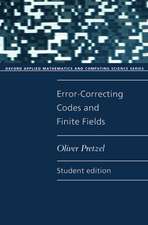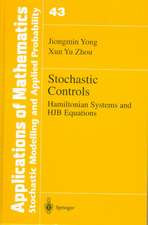Killer Cell Dynamics: Mathematical and Computational Approaches to Immunology: Interdisciplinary Applied Mathematics, cartea 32
Autor Dominik Wodarzen Limba Engleză Hardback – 30 noi 2006
| Toate formatele și edițiile | Preț | Express |
|---|---|---|
| Paperback (1) | 936.30 lei 6-8 săpt. | |
| Springer – dec 2010 | 936.30 lei 6-8 săpt. | |
| Hardback (1) | 940.39 lei 6-8 săpt. | |
| Springer – 30 noi 2006 | 940.39 lei 6-8 săpt. |
Din seria Interdisciplinary Applied Mathematics
- 19%
 Preț: 420.88 lei
Preț: 420.88 lei - 15%
 Preț: 667.05 lei
Preț: 667.05 lei - 20%
 Preț: 664.77 lei
Preț: 664.77 lei - 15%
 Preț: 980.97 lei
Preț: 980.97 lei - 17%
 Preț: 528.45 lei
Preț: 528.45 lei - 9%
 Preț: 630.35 lei
Preț: 630.35 lei - 18%
 Preț: 908.71 lei
Preț: 908.71 lei - 18%
 Preț: 1006.38 lei
Preț: 1006.38 lei - 15%
 Preț: 659.67 lei
Preț: 659.67 lei -
 Preț: 498.14 lei
Preț: 498.14 lei -
 Preț: 528.35 lei
Preț: 528.35 lei - 15%
 Preț: 659.02 lei
Preț: 659.02 lei - 15%
 Preț: 480.52 lei
Preț: 480.52 lei -
 Preț: 390.63 lei
Preț: 390.63 lei - 18%
 Preț: 918.61 lei
Preț: 918.61 lei -
 Preț: 388.52 lei
Preț: 388.52 lei - 15%
 Preț: 647.92 lei
Preț: 647.92 lei - 15%
 Preț: 655.60 lei
Preț: 655.60 lei - 23%
 Preț: 734.81 lei
Preț: 734.81 lei - 15%
 Preț: 660.83 lei
Preț: 660.83 lei - 18%
 Preț: 967.08 lei
Preț: 967.08 lei -
 Preț: 809.10 lei
Preț: 809.10 lei -
 Preț: 403.91 lei
Preț: 403.91 lei - 18%
 Preț: 896.84 lei
Preț: 896.84 lei - 18%
 Preț: 1004.00 lei
Preț: 1004.00 lei - 18%
 Preț: 974.19 lei
Preț: 974.19 lei -
 Preț: 399.67 lei
Preț: 399.67 lei - 23%
 Preț: 639.30 lei
Preț: 639.30 lei
Preț: 940.39 lei
Preț vechi: 1146.82 lei
-18% Nou
Puncte Express: 1411
Preț estimativ în valută:
179.95€ • 192.42$ • 150.03£
179.95€ • 192.42$ • 150.03£
Carte tipărită la comandă
Livrare economică 18 aprilie-02 mai
Preluare comenzi: 021 569.72.76
Specificații
ISBN-13: 9780387308937
ISBN-10: 0387308938
Pagini: 220
Ilustrații: XIII, 220 p.
Dimensiuni: 155 x 235 x 16 mm
Greutate: 0.45 kg
Ediția:2007
Editura: Springer
Colecția Springer
Seria Interdisciplinary Applied Mathematics
Locul publicării:New York, NY, United States
ISBN-10: 0387308938
Pagini: 220
Ilustrații: XIII, 220 p.
Dimensiuni: 155 x 235 x 16 mm
Greutate: 0.45 kg
Ediția:2007
Editura: Springer
Colecția Springer
Seria Interdisciplinary Applied Mathematics
Locul publicării:New York, NY, United States
Public țintă
ResearchCuprins
Viruses and Immune Responses: A Dynamical View.- Models of CTL Responses and Correlates of Virus Control.- CTL Memory.- CD4 T Cell Help.- Immunodominance.- Multiple Infections and CTL Dynamics.- Control versus CTL-Induced Pathology.- Lytic versus Nonlytic Activity.- Dynamical Interactions between CTL and Antibody Responses.- Effector Molecules and CTL Homeostasis.- Virus-Induced Subversion of CTL Responses.- Boosting Immunity against Immunosuppressive Infections.- Evolutionary Aspects of Immunity.
Recenzii
From the reviews:
"This book concentrates on a particular branch of the immune system: killer T cells … . the book provides an introduction to the field of mathematical immunology and an overview together a broad variety of immunological topics. … intended for an interdisciplinary audience, and it is written in a way such that experimental immunologists and virologists should be able to understand the arguments and to see the biological implications of the theory. An interesting text which might be a good complement to this book … ." (Eva Sanchez, Zentralblatt MATH, Vol. 1125 (2), 2008)
"This book concentrates on a particular branch of the immune system: killer T cells … . the book provides an introduction to the field of mathematical immunology and an overview together a broad variety of immunological topics. … intended for an interdisciplinary audience, and it is written in a way such that experimental immunologists and virologists should be able to understand the arguments and to see the biological implications of the theory. An interesting text which might be a good complement to this book … ." (Eva Sanchez, Zentralblatt MATH, Vol. 1125 (2), 2008)
Textul de pe ultima copertă
This book reviews how mathematics can be used in combination with biological data in order to improve understanding of how the immune system works. This is illustrated largely in the context of viral infections. Mathematical models allow scientists to capture complex biological interactions in a clear mathematical language and to follow them to their precise logical conclusions. This can give rise to counter-intuitive insights which would not be attained by experiments alone, and can be used for the design of further experiments in order to address the mathematical results.
This book provides both an introduction to the field of mathematical immunology, and an overview of many topics which are the subject of current research, covering a broad variety of immunological topics. It starts with basic principles of immunology and covers the dynamical interactions between the immune system and specific viral infections, including important human pathogens such as HIV. General biological and mathematical background material to both virus infection and immune system dynamics is provided, and each chapter begins with a simple introduction to the biological questions examined.
This book is intended for an interdisciplinary audience. It explains the concept of mathematical modeling in immunology and shows how modeling has been used to address specific questions. It is intended both for the mathematical biologists who are interested in immunology, and for the biological readership that is interested in the use of mathematical models in immunology. Dominik Wodarz is an Associate Professor at the Department of Ecology and Evolutionary Biology at the University of California, Irvine.
This book provides both an introduction to the field of mathematical immunology, and an overview of many topics which are the subject of current research, covering a broad variety of immunological topics. It starts with basic principles of immunology and covers the dynamical interactions between the immune system and specific viral infections, including important human pathogens such as HIV. General biological and mathematical background material to both virus infection and immune system dynamics is provided, and each chapter begins with a simple introduction to the biological questions examined.
This book is intended for an interdisciplinary audience. It explains the concept of mathematical modeling in immunology and shows how modeling has been used to address specific questions. It is intended both for the mathematical biologists who are interested in immunology, and for the biological readership that is interested in the use of mathematical models in immunology. Dominik Wodarz is an Associate Professor at the Department of Ecology and Evolutionary Biology at the University of California, Irvine.
Caracteristici
Prominent area of research in the biomedical community Review of mathematical and computational approaches used to help understand how killer T cell responses work to fight viral infections Chapter summaries Chapter applications Large amount of graphics














